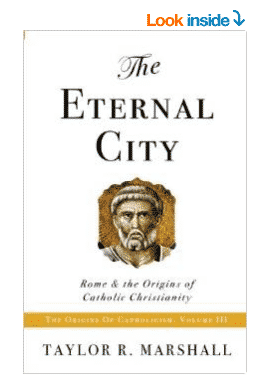The Roman Church as Prophesied in the Old Testament
Did you know that the “Roman identity” of the New Testament Church was foretold in the Old Testament? If we understand the Jewish prophets, we will see that the Church of Jesus Christ would necessarily be “Roman.”
It relates to a vision found in the second chapter of Daniel. This chapter describes a dream of Nebuchadnezzar about an enormous statue composed of four different materials. First, the head was of gold. Second, the chest and arms were of silver. Third, the belly and thighs were of bronze. Fourth, the legs and feet were of iron and clay. According to the vision, a stone will be hewn from a mountain without human hands and cast into the statue. This small rock smashes against the statue’s iron and clay feet, which causes the entire statue to crumble. Then the small rock becomes a great mountain and fills the entire earth.
Daniel interpreted the dream in the following way. First, the golden head was Nebuchadnezzar and his Babylonian Empire. Next, an inferior kingdom would then follow the Babylonian Empire, as silver is inferior to gold. Then, a third kingdom would arise inferior to the second kingdom, as bronze is inferior to silver. Lastly a fourth kingdom would arise that was different than the previous three. As for the small uncut rock cast down from Heaven, Daniel explains:
And in the days of those kings, the God of heaven will set up a kingdom that shall never be destroyed, nor shall its sovereignty be left to another people. It shall break in pieces all these kingdoms and bring them to an end, and it shall stand forever; just as you saw that a stone was cut from a mountain by no human hand, and that it broke in pieces the iron, the bronze, the clay, the silver, and the gold. A great God has made known to the king what shall be hereafter. The dream is certain, and its interpretation sure (Dan 2:44-45).
The stone from Heaven in the days of the Fourth Kingdom signifies that “the God of heaven will set up a kingdom that shall never be destroyed.”
Looking in back in time, we understand the prophecy as corresponding to the following historical chronology when heathen kingdoms ruled over the Jews:
- Babylonian Empire (ca. 587-539 B.C.)
- Medo-Persian Empire (ca. 539-331 B.C.)
- Greek Empire (ca. 331-168 B.C.)
- Roman Empire (ca. 63 B.C.-A.D. 70)
It was in fact in the days of the Fourth Kingdom, the Roman Empire that God established His Messianic Kingdom:
In those days a decree went out from Caesar Augustus that all the world should be enrolled…And Joseph also went up from Galilee, from the city of Nazareth, to Judea, to the city of David, which is called Bethlehem, because he was of the house and lineage of David, to be enrolled with Mary, his betrothed, who was with child. And while they were there, the time came for her to be delivered (Lk 2:1-6).
It is also common knowledge that Christ was crucified under Pontius Pilate, the Roman governor of Judea. From a historical point of view we see that the Rock of Ages came crashing into the Roman Empire. The Kingdom of Christ began precisely when Daniel predicted—during the era of the Fourth Kingdom, the Kingdom of Rome.
It is important to note here that the Four Kingdoms of the Gentiles also began to anticipate a Messiah in their own way. Ezekiel and Daniel called King Nebuchadnezzar of Babylon “the King of Kings” (Ezek 26:7; Daniel 2:37), a title given subsequently to Jesus Christ. Isaiah called King Cyrus of Persia “the Messiah” (Isaiah 45:1), a surprising use of the term for a Gentile king! Alexander the Great of Greece united the Mediterranean world, had himself proclaimed the “Son of God,” and died at the age of thirty-three. The Greco-Syrian ruler Antiochus IV later ruled the Promised Land, desecrated the Temple, and in turn became a type of the False Messiah or Antichrist. But it was Rome that was the final “kingdom” and it was inherited by Christ and His saints.
As we see in Daniel 2, “[Rome’s] sovereignty shall be left to another people” and it would happen through the introduction of a stone or rock – a Petros or Peter!
The section above was an excerpt from The Eternal City: Rome and the Origins of Catholicism. To learn more about the “Theology of Rome” or Romalogy, take a look at my book.
[reminder]
What to Watch Next
SHOP THE TAYLOR MARSHALL STORE
Dive Deeper

GET CONFIDENT IN YOUR FAITH
Explore the fascinating world of Catholic teachings with Dr. Marshall. Together you’ll unpack the brilliant answers the Church gives to tough questions about the Faith. The best part: you go at your own pace. Start this exciting journey today.


 >
>




